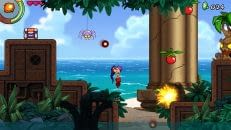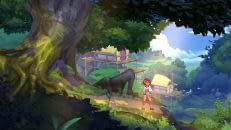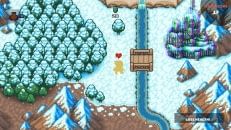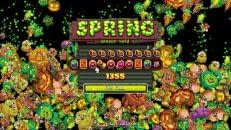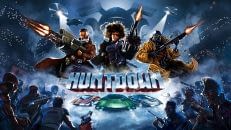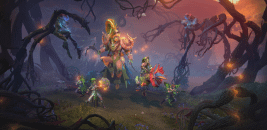Interview: Hidden in Plain Sight
Earlier this week, I mentioned that local multiplayer was a delicious gaming morsel that was fading away, yet one that still has the potential to cut a formidable figure in the indie games landscape. Its value as a nostalgic throwback to the delightful days of social gaming in its raw, untampered form is, you might say, Hidden In Plain Sight. And that’s a mighty coincidence because that’s the name of a brand new indie game based fundamentally on that very premise.
Here, then, as promised, is our interview with Adam Spragg, the hobbyist developer of Hidden in Plain Sight with a passion for local multiplayer gaming. The game’s set for release through the Xbox Live Indie Games service on November 18th, so be sure to at least give it a look. It’s available at a mere 80 Microsoft Points too, making it cheaper than most of those tawdry avatar accessories that Microsoft seems intent on shovelling out on a daily basis. What follows is a refreshing story of creative dynamism stemming from a deep-held love of the gaming medium, and any gaming fan should make sure to give it a read.
IGM: Hi, Adam. Thanks for taking the time to answer our questions. First of all, could you provide us with a brief description of Hidden in Plain Sight and how its basic game mechanics work?
Adam Spragg (AS): Hidden in Plain Sight is a set of multiplayer game modes centered around subtlety, disguise and conflict. In each game mode, each player controls a character in the midst of a crowd of NPCs. The NPCs are dumb: they just wander around randomly. Players are given the means to eliminate each other from the game, as well as various tasks to accomplish, like collecting coins or winning a race.
So the goal of the game is to try to accomplish these goals while still blending in with the NPCs, and at the same time, hunting and eliminating other players.
There’s a lot of hide-and-seek, cat-and-mouse kind of tension that is really a lot of fun.
IGM: The game appears to be strongly based around the creation of a tense, heart-pounding atmosphere. Would you say that this theme helps distinguish the game from the vast majority of other titles available on the XBLIG service?
AS: Yes. In general, I’m interested in creating games that are fresh and original to the platform. I’m certainly not familiar with every game, but I’m sure I haven’t seen one like it on the XBLIG service. There are a certain number of horror-themed games, but I’m guessing they derive their tension and atmosphere through narrative. And there are obviously multiplayer games, but I haven’t seen any that are slow-paced and tense and cerebral.
IGM: Can you tell us anything about the game’s art style? How did you go about creating Hidden In Plain Sight’s aesthetics?
AS: Hidden in Plain Sight uses character sprites that are freely available on the web for anyone to use, as long as they give credit to the author (Renier Prokein). I’m a terrible artist, and I try to make games on as limited a budget as I can, so I have no problem at all scrounging for whatever free assets I can get. So, in that sense, creating a strong visual identity (like, say, Limbo or Monaco) to me is a luxury, rather than a necessity. I definitely care more about playability and fun. Packaging and external gloss are secondary.
IGM: Would you say that the in-game music adds to the aforementioned generation of tension within each of the game modes?
AS: Absolutely. A friend of mine is married to a guy who writes music for TV shows and so forth, and he was extremely generous by giving me permission to use some of his music in my game. I think it adds a huge amount to the mood and atmosphere.
IGM: With five separate game modes in place, the game looks as though it has a fairly significant amount of variety on offer. Was this a conscious decision that you made in order to expand its lifespan in a day and age in which many indie games are criticized for being too short-lived and lacking in replayability?
AS: No, that really wasn’t my explicit goal. I felt I had a strong central theme, and my code is modular and reusable, so adding additional game modes simply came naturally as new ideas popped up. I came up with the Death Race game mode idea while driving home one evening, and within a few hours it was added to the game. I think you’re right in that there is a lot of replay value, but that was coincidental to me simply having fun adding additional modes.
At some point, it occurred to me that I could probably split the game and sell the pieces as individual games. But that somehow felt dishonest.
IGM: You’ve stated that Hidden in Plain Sight’s status as a local multiplayer-only title might turn off some sections of the gaming community, particularly those who enjoy the elements commonly associated with online multiplayer, such as matchmaking and online leaderboards. If the game is reasonably successful, would you ever consider introducing some form of online multiplayer?
AS: Absolutely not. And there are two reasons for this. First of all, there are several design decisions in my game that are specifically designed for multiple players sharing the same TV screen. And there is something really fun about playing with your opponent sitting in the same room. I grew up in the era of shared-screen multiplayer, and it has a place in my heart.
Secondly, online multiplayer is a quite complex subject technically. It’s a lot of work, and requires a lot of players to buy the game in order to make it worthwhile. Frankly, I’m not convinced the effort is worth it for a game that may only sell a few hundred or thousand copies. Is it worth adding if it’s difficult to find an opponent? Kind of a chicken-and-egg situation, I guess.
One of the main selling points for my last game, Battle for Venga Islands, was that it simulated a persistent online world that changed as players played the game. And for a while, it worked really well. But as time passed and players moved away from the game, I realized the main selling point was turning into a bait-and-switch for new people buying the game. New players couldn’t find any peers to connect with. So I pulled the game.
IGM: It’s clear that the tactics employed by participants in multiplayer games can often change dramatically depending on how many people are playing simultaneously. With that in mind, how would you say that the experience of Hidden in Plain Sight differs when more than two people get involved at once?
AS: It really depends on the game mode. Ninja Party is kind of analogous to a straight deathmatch style game. Think of how much a deathmatch changes when it is simply 1v1, rather than having three or four players. It adds many layers of complexity.
In Knights vs. Ninjas, the ninja moves faster than the knights, so it’s not a very interesting game played 1v1. That game really lends itself better to 2v1 or 2v2 gameplay, when teamwork and timed coordinated attacks really come into play.
IGM: Obviously, this is a hobbyist game, so I’m guessing that you’re releasing it out of your love for video games, rather than harbouring hopes of making significant amounts of money. If that’s the case, do you have any particular goal in mind in terms of download figures and the type of revenue you’re expecting to make?
AS: I’m a professional software developer with a career and family. Making games is a leisure activity for me. To that end, I’ve adopted a personal motto: “If you’re not having fun, you’re not doing it right.” Obviously, I’d love to have a game go viral and sell a million copies, but realistically, I just have fun releasing it and knowing people play it and enjoy it. Setting download goals and revenue expectations feels like a quick way to turn “fun” into “anxiety” and “disappointment”.
I recently got an email from a kid who played Bad Golf (my first XBLIG game), and he called a “perfect gaming experience”. He begged me to make a sequel. That means a lot more to me than sales figures (to a reasonable extent, I suppose).
IGM: Is there any particular advice you’d give to other hobbyist developers out there?
AS: In my opinion, someone who categorizes themselves as a “hobbyist developer” has already won the game. My advice would be to “stay the course.” If you are a game developer simply because you have a passion for creating games, rather than trying to meet a bottom line, you suddenly free yourself from all sorts of constraints. You can follow your dreams and make more experimental games, and have fun doing it. Or if you aren’t having fun, you can simply drop the project and start something else. The world is your oyster.
That all presupposes the standard “beginning game developer” advice: start small, learn your tools, set low expectations, etc.
IGM: Upon watching footage of Hidden in Plain Sight in action, it seems to me to contain elements from several different sources, ranging from other video games, such as Spy Party and Assassin’s Creed: Brotherhood, to non-video game related activities, such as Cluedo and Murder in the Dark. What would you say has provided you with the strongest inspiration for your game?
AS: The major initial inspiration was ,Spy Party, a game in development by Chris Hecker. It’s the first game I’d heard of that uses an “inverse Turing test” mechanism, where the human player is trying to blend in and act like a computer controlled character. When I first read about it, I wondered if the essence of game could be boiled down to a simpler 2D arcade-y environment, and whipped up a private prototype which I brazenly called “SpyParty2D.” I showed it to some friends, but never planned on doing anything with it. But that was the initial seed from which Hidden in Plain Sight spawned.
I actually emailed Chris Hecker as I was finishing up this game. I feel my game has enough originality to stand on its own, so I wasn’t apologizing or asking his permission, but I still wanted to make sure I wasn’t crossing some line in the sand. Chris was very cool about it, and said in no uncertain terms that there was plenty of gold to be mined in this genre, and he was fine with derivative games as long as they “moved the design ball forward.” This is my attempt to do that.
IGM: Thanks for your time, Adam. All the best for the game’s release.
Hidden In Plain Sight will be available on the Xbox Live Indie Games service from November 18th at the price of 80 Microsoft Points.

